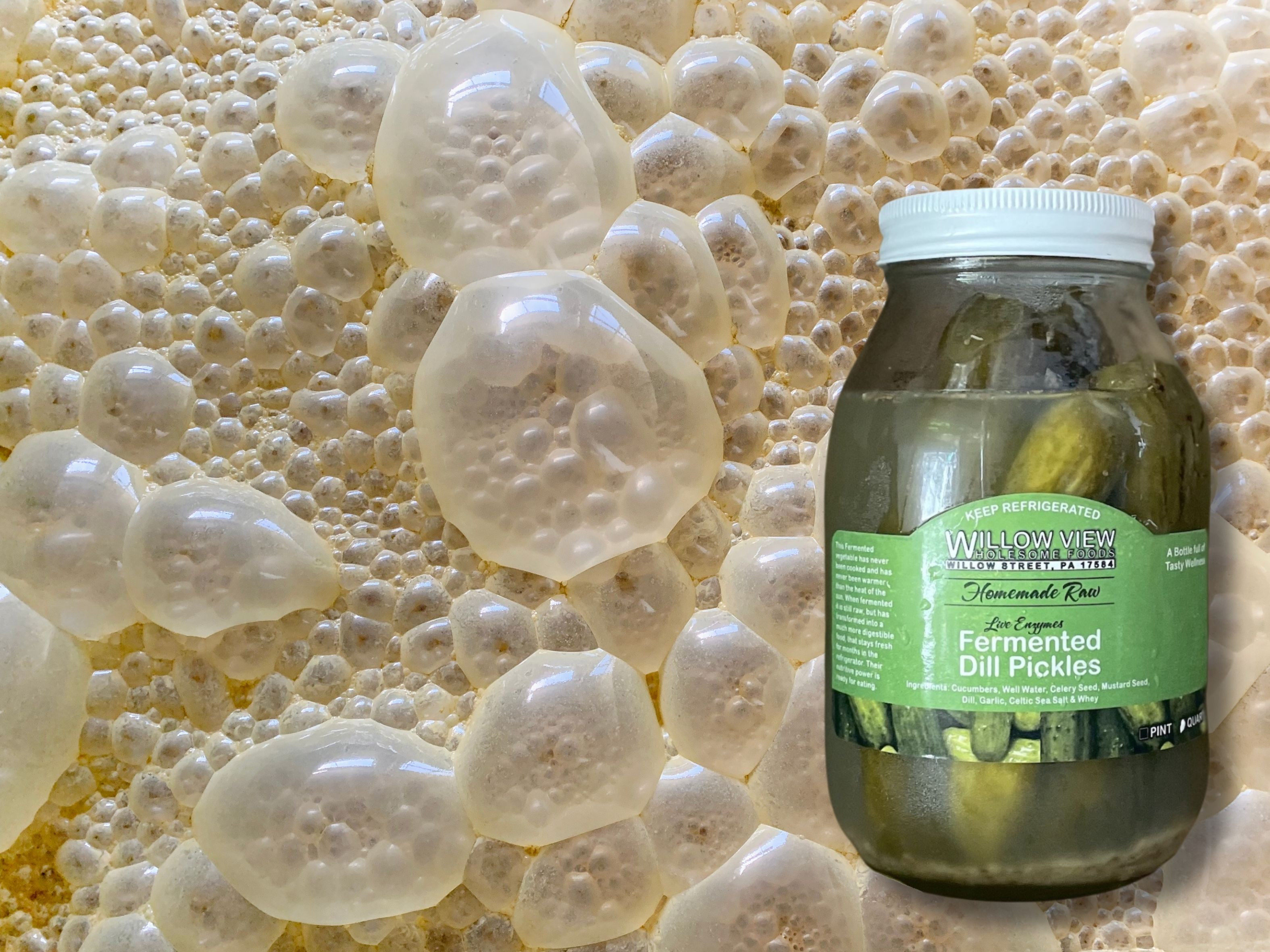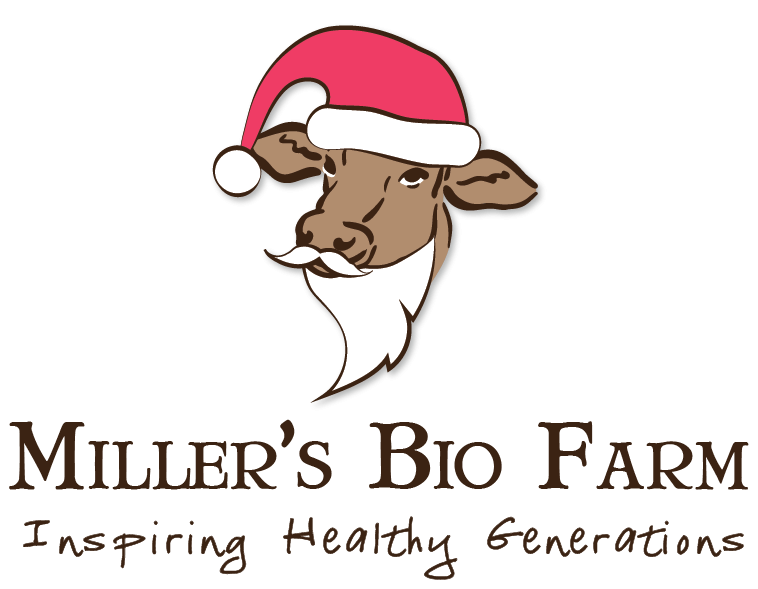See a volcano of pickles! The pluses and minuses of natural ferments.
posted on
May 9, 2025

A customer shared his farm food order with us on Instagram. Thanks for sharing, Nick! It included this amazing video of the volcano that can erupt from our fermented pickles:
What's going on here? Why so many bubbles? Conventional pasteurized vinegar pickles (you know, the kind that are considered "normal") don't bubble at all.
What you're seeing is the fermentation.
When fermented pickles are made, it's a very simple process. The following is mixed in a jar: Cucumbers, well water, celery seed, mustard seed, dill, garlic, Celtic sea salt, and whey. Then, the jar sits with a loose lid for 3-7 days, until it's done fermenting.
The seeds and herbs are in there for flavor only. The cucumbers, water, salt, and whey are what make the magic happen.
Note that there is no powdered culture added. Yes, whey is added and it has probiotics, but it simply helps jumpstart the ferment. Even without the whey, those pickles would ferment. It would just take a little longer.
This is because raw veggies naturally have lactic acid bacteria (LAB) in them. When you mix them with water and salt, it creates the perfect environment for them to grow. Pretty cool, right?
The living microbiology (the LAB) grow and multiply. They eat the naturally occurring sugars and starches in the cucumbers and produce CO2, a gas.
The fermentation carbonated the pickle brine! The fermentation made the volcano! It's also a sure sign that there's plenty of good probiotic stuff for your gut in that jar.
The white stuff is yeast (most likely KAHM yeast).
Another thing to notice in the jar is how the liquid is whitish, not clear. There's nothing unsafe about it. Yes, you can eat it! It's a natural part of fermentation.
You see, KAHM yeast thrives in acidic environments. As that probiotic goodness ferments and creates CO2, it also creates lactic acid. The lactic acid not only gives pickles their distinct sour flavor but also makes the brine acidic.
KAHM yeast is naturally in the air. It will land on a ferment and think "Gee, this would be a great home." And then it grows. It typically makes a film on the top of a ferment, but it can also sink to the bottom. With volcanic pickles, it gets all mixed up in the brine and will eventually settle.
Fermented veggies are an acquired taste.
Nick, who shared the volcanic pickles video, reported that: "The pickles are absolutely delicious. I love them!"
But... we sometimes get complaints about the flavor of the pickles and the white stuff. Is Nick's palate simply more accustomed to ferments? Were some jars of pickles actually off? It's really hard to say... especially when you're not there smelling and tasting it yourself.
What I do know is that fermented veggies are an acquired taste. They're very different from the distinct pasteurized vinegar pickle flavor you likely grew up with.
Fermented pickles have umami to them (think about that "weird" flavor in miso or a very sharp aged cheese). They have a lot of tang. They can even taste metallic. Some may feel a burn on their tongue (that's the lactic acid by the way).
You may want to try making some at home (as I said before, it's pretty easy). That way, you can taste the flavor throughout the fermentation process and put it in the fridge when you think they're just right.
Fermented veggies can last months in the fridge with proper maintenance.
Here are a few tips to keep them in their best shape.
Always store in the fridge. This will slow down the fermentation so they don't get overdone. If you leave them on the counter (especially pickles), they'll get quite sour and mushy pretty quickly. Never freeze ferments. They'll just get mushy.
Make sure the veggies are always covered with brine. If the brine falls below the veggies, simply add more water and sea salt. So easy! If the veggies aren't covered, they can grow mold or dry out and become yucky.
If there's too much KAHM yeast, remove it. KAHM yeast is perfectly safe to eat. However, it can have an off-putting flavor, especially when there's too much. If it's on the top of the brine, simply scoop it off. If it's all mixed up in the brine, let the jar sit for a day or two so it settles. Once it sinks to the bottom of the jar, you can remove the pickles and clean brine (leaving the white stuff at the bottom), clean the jar, and then put the pickles and brine back in. Voila!
With this in mind, you might be wondering...
Can ferments become unsafe?
If a lacto-fermented veggie goes wrong, it will be pretty obvious. It may have a repulsive smell, flashy colors (like pink or black mold), or a foul flavor. While a normal ferment should have a sour, tangy smell, a bad ferment will smell putrid or rotten.
This can be a little tricky, especially if you're new to ferments. The flavor can be wild! Often you simply need to trust your gut.
Although getting used to ferments can take some time and know how, it's worth it.
Why? They're just so darn good for your gut. They're packed with a range of lactic acid bacteria. Fermented veggies usually have bifidobacteria, too, which isn't prevalent in fermented dairy but is crucial for healthy digestion.
When you have robust and healthy gut microbiology:
- The bad stuff simply can't grow. You're less likely to get sick.
- Your digestion is better overall, meaning that you get max nutrition from the food you eat.
- Your gut can better produce essential nutrients like short-chain fatty acids and vitamins B1, B9, B12, and K.
- You can experience less inflammation.
- Your gut-brain connection is better. You may find yourself in a better mood, with less stress.
There's probably so much more, but those are the top ones for me!
Do you eat or make ferments? Why or why not? Have you tried the pickles? What's your experience?
I'd love to hear from you! Comment below (no account required - start typing for the guest option to appear) or contact us.




